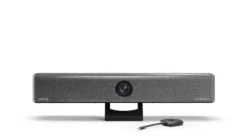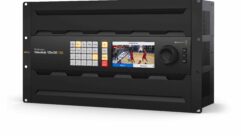

Telepresence 101: Can You See Me Now?
We see through a glass darkly, but then we shall see face to face. Words to this effect , while originally uttered in an entirely different context, have been repeated since the inception of the video teleconferencing age.
COMMUNICATION FILTERS
Thom Mullins, CTS
“WE SEE THROUGH A GLASS DARKLY, BUT THEN WE SHALL see face to face.” Words to this effect , while originally uttered in an entirely different context, have been repeated since the inception of the video teleconferencing age. And we hear them again and again whenever the latest wave of teleconferencing equipment arrives and people have a chance to interact with the state-of-the-art technology. Is the glass any clearer now that we’ve entered the “age of telepresence?” Yes and no.
I was first exposed to video teleconferencing when I worked for a contractor in Alaska. We were interested in the field because of our business with oil companies working on the North Slope and their need to communicate among home and regional offices and their crews in the oil fields. In the education systems, the technology could link a remote village school to resources in a larger city. It was a grand and heady time.
It was also a time of “slow-scan,” or 15-frames-per-second video, displayed on television sets with horrible audio in purpose-built buildings. Ironically, we had large amounts of bandwidth, available only from the telecom providers that underwrote much of the development of these systems. They gave us engineering, design, and operations support; equipment; satellites; and a host of other services to advance the clients’ communications needs. They also used it as an opportunity to advance the systems—if only a little.
Now we’ve arrived in the telepresence age. What does that mean? Just as television is “sight at a distance,” telepresence is “presence at a distance.” It’s really what the industry has been after all along—and it’s now the gold standard by which the end-user and industry measure progress.
Using technology, can we replicate a face-to-face conversation and make it appear as natural as an in-person meeting? Can we read tonal inflections and observe body language? Will this improve our confidence in those on the other end? If so, we will have arrived. If not, it’s back to the drawing board.
Whenever we use technology to solve a problem, we insert filters into the communications process. These filters include the location and quantity of microphones and loudspeakers; architectural acoustics; room lighting; camera location; display size and resolution; connection speed; and the list goes on.
To one extent or another, we’re still dealing with those filters today. So how do the new systems measure up to the telepresence gold standard? Do they deliver on the promise?
For higher-end systems, attention to environmental and human factors is beginning to pay off. One of the first telepresence rooms demonstrated by NEC and IBM at InfoComm was arranged to trick you into thinking you were walking into a conference room where both teams were meeting. Room lighting was correct, acoustical issues had been addressed, and the technology was not readily apparent. The display technology used a pair of rear-projection units with such a thin reveal between them that it was almost non-existent. The big innovation, in my mind, was that a firm was finally paying attention to all the human factors that impact communications.
Audio bandwidth has improved tremendously—the result of using better analog-to-digital and digital-to-analog conversion algorithms to eliminate the brittle sound so common in VoIP systems. Newer systems also take advantage of wider bandwidth and better processing algorithms to reduce video lag.
Still, while displays have gotten larger, the presence of wide black trim separating the far-site meeting participants can be a jarring reminder of the technology being used. And the systems I’ve observed in action still must account for certain acoustical issues. I’ve seen people tiring easily because of the effort it takes to sift the useful audible information from the reverberation at both far- and near-site locations. It’s still one of the most common end-user complaints I hear.
Telepresence 101: Can You See Me Now?
We see through a glass darkly, but then we shall see face to face. Words to this effect , while originally uttered in an entirely different context, have been repeated since the inception of the video teleconferencing age.
COST HURDLES
The solutions to these issues are well understood and relatively easy and inexpensive to implement at the beginning of a project. Unfortunately, architects and owners often see them as easy targets when it comes time to cut project costs.
Telepresence comes at a price—sometimes a big one. Prices have dropped considerably over the past decade (from over $800,000 per end to around $300,000 per end), and quality has improved tremendously. But not all the cost of a room is in the hardware.
There are still basic costs associated with the room construction that must be addressed. Unfortunately, those costs have remained constant and now make up a bigger percentage of the overall cost of a system than they did before. If it were possible to control noise, reverberation, and extraneous lighting by applying still more layers of technology, it would have been done by now. The laws of physics don’t cut us any slack; careful design, installation, and construction techniques still yield the best results.
Part of the cost depends on end-user expectations. Telepresence is different from using an eyeball camera and headset while viewing postage-stamp images for online meetings. What has been the end-users’ experiences with previous systems, and how do they want to improve the experience? Can they perceive differences? Are they willing to pay for those differences?
Aside from cost, ease of use remains an issue. Can the experience be as simple as walking into a room and waiting for the other side to appear? As control and teleconferencing bridges become more integrated with IT networks and scheduling software, this is becoming less of an issue. But it still requires effort and coordination with the IT department to pull off. And we’re just in the beginning stages of defining unified communications (UC) which will add another layer of complexity.
But the single biggest challenge still facing the industry is interoperability. If a corporation is going to invest in the technology, it will likely purchase equipment from a single vendor, which reduces its own interoperability issues considerably. But really, how much communicating takes place solely within the organization and how much takes place with other groups that may not share equipment standards?
As long as manufacturers “enhance” their systems with add-ons that operate a little differently than the competition, or release their latest solutions before a standard is agreed on, there will continue to be problems getting systems—and people—to talk with one another. It can still be done, but usually at the lowest common denominator between the systems. This usually results in lower bandwidth, poorer image quality, inferior audio quality, and glitches in the communications process. That doesn’t hit the mark.
Put aside parochial attitudes and “gotcha” gimmicks; it’s limiting the marketplace. The sooner manufacturers learn to work within standards, the sooner the market can grow and develop—and the sooner we’ll be talking face to face.
Thom Mullins is a senior consultant with BRC Acoustics & Technology Consulting in Seattle. He can be reached at [email protected].










